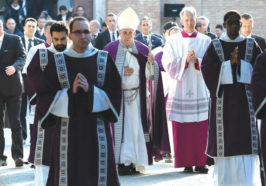Although there was a collective effort by the Catholic Church to save Jewish children, many questions remain, such as the degree of the pontiff’s involvement and the underlying motivation.
BY BARUCH TENEMBAUM, EDUARDO EURNEKIAN – MARCH 9, 2019
For many years, the figure of Pope Pius XII was both vilified and defended in connection to his alleged role during the Holocaust.
His detractors believe the pontiff tolerated the advent of Nazism, and later, did not raise his voice to protect the Jews.
His defenders, especially the Vatican, claim that Pius XII did protect the Jews behind the scenes, and opted not to be outspoken against the Nazi atrocities for fear it would prove counterproductive.
This fierce controversy has a chance to come to an end if the Vatican will fully open its secret WWII-era archives, and offer free and unfettered access to historians and researchers in search of the truth.
According to Pope Francis, this will occur on March 2, 2020, coinciding with the 144th anniversary of Eugenio Pacelli’s birth and the 81th anniversary of the commencement of his papacy.
Back in 2014, the International Raoul Wallenberg Foundation launched its Houses of Life program. Its objective is to identify and recognize sites across Europe that provided shelter to the victims of Nazism, mostly children who were left by their parents who faced deportation to the concentration camps.
In the last five years, our NGO has managed to identify well over 500 Houses of Life in Italy, France, Belgium, Poland, Hungary, the Netherlands, Denmark, Greece and Albania, and the numbers are growing on a daily basis. Our intention is to fix a commemorative plaque on the facade of each building, explaining the feats of heroism which took place under its roof. The aim is to educate visitors and passersby about the heroes who stood up against evil in the darkest era known to humankind.
The statistical data in our hands show that the majority of Houses of Life were churches, convents, monasteries and boarding schools connected to the Roman Catholic Church. In our view, this has extraordinary significance, as it hints of a well-orchestrated rescue effort within a hierarchic organization and hence, one might surmise that the highest ecclesiastical echelons, including Pope Pius XII, who must have known this, or even directed and encouraged this magnificent operation.
Many of the rescued children did not get back to their biological parents, for they perished in the Nazi death camps. Some of them became Catholic, or even priests and nuns. Others were retrieved by their original families and kept their faith, oftentimes with the encouragement of those rescuers who did not hide from them the fact they were Jewish.
The Houses of Life program teaches us that there was a collective effort by the Catholic Church to save Jewish children. Still, many questions remain pending, such as the degree of involvement of the pontiff, and the underlying motivations of these life-saving feats.
To be sure, the free access to the archives will shed light into these and broader questions in regard to the role played by the Holy See during one of most tragic chapters of history.
Eduardo Eurnekian and Baruch Tenembaum are chairman and founder of the International Raoul Wallenberg Foundation, respectively.

